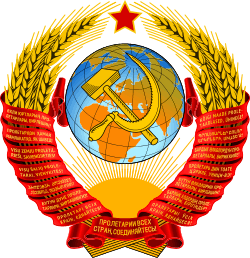Buryat Autonomous Soviet Socialist Republic
| Buryat Autonomous Soviet Socialist Republic Бурятская Автономная Советская Социалистическая Республика Буряадай Автономито Совет Социалис Республика | ||||||
| Autonomous republic of the Russian SFSR | ||||||
| ||||||
| ||||||
.svg.png) | ||||||
| Capital | Ulan-Ude | |||||
| History | ||||||
| • | Established | 30 March 1923 | ||||
| • | Disestablished | 1990 | ||||
| Area | ||||||
| • | 1923 | 69,857 km2 (26,972 sq mi) | ||||
| Population | ||||||
| • | 1923 | 118,000 | ||||
| Density | 1.7 /km2 (4.4 /sq mi) | |||||
The Buryat Autonomous Soviet Socialist Republic (Buryat: Буряадай Автономито Совет Социалис Республика; Russian: Бурятская Автономная Советская Социалистическая Республика) was an Autonomous Soviet Socialist Republic of the Russian SFSR in the Soviet Union.
In 1923, the republic was created with the name Buryat-Mongol Autonomous Soviet Socialist Republic; its predecessor was the Buryat-Mongol Autonomous Oblast. In 1958, the name "Mongol" was removed from the name of the republic. The Buryat ASSR declared its sovereignty in 1990 and adopted the name Republic of Buryatia in 1992. However, it remained an autonomous republic within the Russian Federation.
In the 1930s, Buryat-Mongolia was one of the sites of Soviet studies aimed to disprove Nazi race theories. Amongst other things, Soviet physicians studied the "endurance and fatigue levels" of Russian, Buryat-Mongol, and Russian-Buryat-Mongol workers to prove that all three groups were equally able.[1]

See also
References
- ↑ Template:First=Francine


